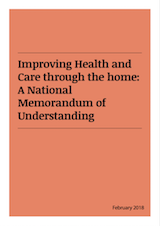Housing – Getting People Home from Hospital
This interactive map, developed by Foundations and the Housing LIN, highlights examples of where housing organisations and services are, or have been actively supporting hospital discharges and helping to get people home. It is also referenced in the government’s High Impact Changes Model which now also specifically covers housing (see Change 9).
This map also displays NHS England-reported data showing the number of delayed discharges of care from hospital arising from housing issues (showing the period between January – December 2017). We are currently working with Foundation to include the latest published data.
Launch the tool
About the Tool
This interactive map developed by Foundations and the Housing LIN provides an insight into the range of projects delivered by providers of housing support and local housing authorities to address situations where discharges from care were being delayed because a housing issue was not addressed in time.
This map also displays NHS England-reported data showing the number of delayed discharges of care from hospital arising from housing issues across England. Between January – December 2017, NHS hospital trusts reported over 110,000 days lost to the NHS due to delayed discharges from hospital arising from a housing or related issue.
This map contributes to the updated Health & Housing Memorandum of Understanding, in particular, to support national and local dialogue and information exchange to inform better strategic decision making across government, health, social care and housing sectors.
As set out in the NHF’s report by the Housing LIN, Home from hospital: How housing services are relieving pressure on the NHS, the main groups affected by delayed transfers of care are older people, people with mental health problems, and people experiencing homelessness.
To illustrate the scale of the pressures:
- There are more than 10.3 million older people over the age of 65 in the UK (opens new window) – an 80% increase since the 1950s
- The proportion of the population aged 85 and over is projected to double over next 25 years (opens new window), to over 3.4 million people
- 18% increase in 5 years in emergency hospital admissions of older patients (opens new window)
- 62% of hospital bed days occupied by people aged 65 or over (opens new window)
- 31% increase in delayed transfers for older people between 2013–2015 (opens new window)
- In 2014/15 there were 1.6 million total delayed bed days in England (opens new window), which averages at approximately 4,500 delayed transfers of care per day
- £820 million: estimated gross cost to NHS of older patients in hospital beds, who are no longer in need of acute treatment (opens new window)
- £180 million: estimated cost of providing alternative care for older people who no longer need to be in hospital, either at home or in another care setting [Ibid]
- People with mental health needs, of all ages, are also significantly affected. An estimated 1 in 20 bed days are used by people experiencing a delayed discharge in a mental health setting (opens new window)
- Meanwhile, homeless people use four times as many acute health services and eight times as many inpatient health services as the general population, but receive lower levels of follow-up care [Ibid]
Housing providers, and other community organisations which deliver housing related services, are well placed to relieve pressure on the NHS, through their work to help people out of hospital and into a suitable home with the right support. The types of services represented in this directory break down broadly into four key categories:
- Co-located / embedded caseworkers (often within hospital discharge teams), linked to a community-based handyperson’s service to deliver practical support in the home;
- Co-located / embedded housing support, focused on providing assessment and holistic community navigation, based within a hospital discharge team;
- Community-based practical housing support, including handyperson’s services, focused on preventing admissions to hospital as well as supporting patients in transition and on their return home; and,
- Step down beds and apartments provided within a housing setting, to enable prompt hospital discharge before a patient is ready to return home.
The purpose of this directory is to showcase the wide geographical spread of these innovative projects and services; visually highlight the excellent work that housing providers (and other community organisations delivering housing related services) are doing to support the NHS; and encourage people to come forward with new examples which can be used to build up the directory further. If you know of additional examples, please complete this template (opens new window) and send it to info@housinglin.org.uk
These project and service examples have been sourced directly from providers and organisations who responded to a Foundations / Housing LIN call for examples, and also from published work from 2017 by the National Housing Federation, the Housing LIN, Skills for Care, the Chartered Institute for Housing, and Care and Repair England. Accordingly, these examples represent a valuable snapshot of a range of innovative services being delivered across England, but are not subject to ongoing updates, so actual delivery on the ground, depending on local commissioning or funding arrangements, may be subject to change.
Tool developed by:









